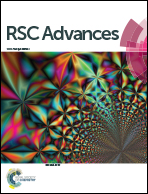Microwave hydrothermal growth of In2S3 interconnected nanoflowers and nanoparticles on graphene for high-performance Li-ion batteries
Abstract
This paper reports microwave-assisted fast hydrothermal synthesis of In2S3 nanoparticles and unprecedented interconnected nanoflowers on graphene surface. The growth mechanisms for various In2S3-based products are investigated. These obtained In2S3 nanoparticles and nanoflowers are found to be uniformly dispersed on graphene nanosheets, forming sandwiched particle-on-sheet and unprecedented flower-on-sheet nanostructures. When fabricated as anode materials, In2S3–graphene composites show extraordinary large reversible capacities and good cycling performances and high rate capabilities. A reversible initial lithium-extraction capacity of 1249 mA h g−1 is observed for the novel In2S3–graphene flower-on-sheet nanostructure at 70 mA g−1, which can be retained at 913, 782, 690 mA h g−1 at large currents of 700, 1400, 3500 mA g−1 respectively. In comparison, the In2S3–graphene nanoparticle-on-sheet composite shows slightly lower reversible capacities but more stable cycling performances at both small and high currents mainly due to the presence of more graphene.


 Please wait while we load your content...
Please wait while we load your content...